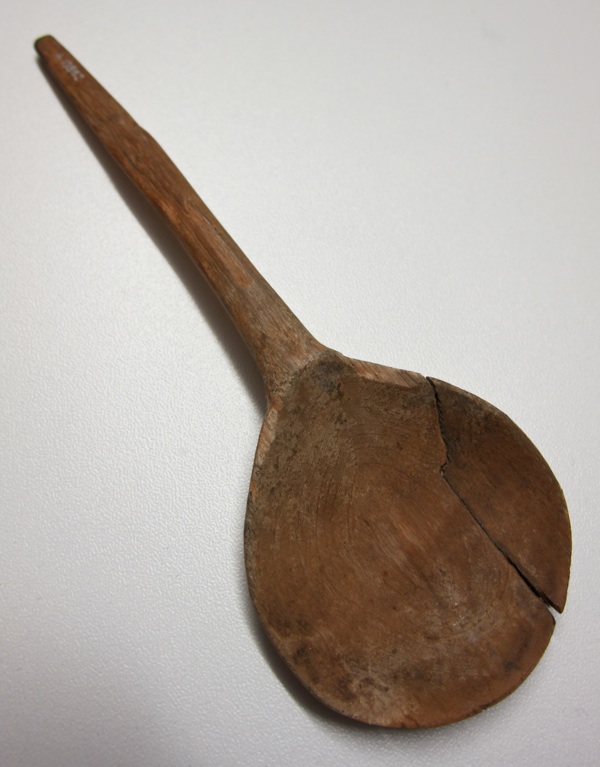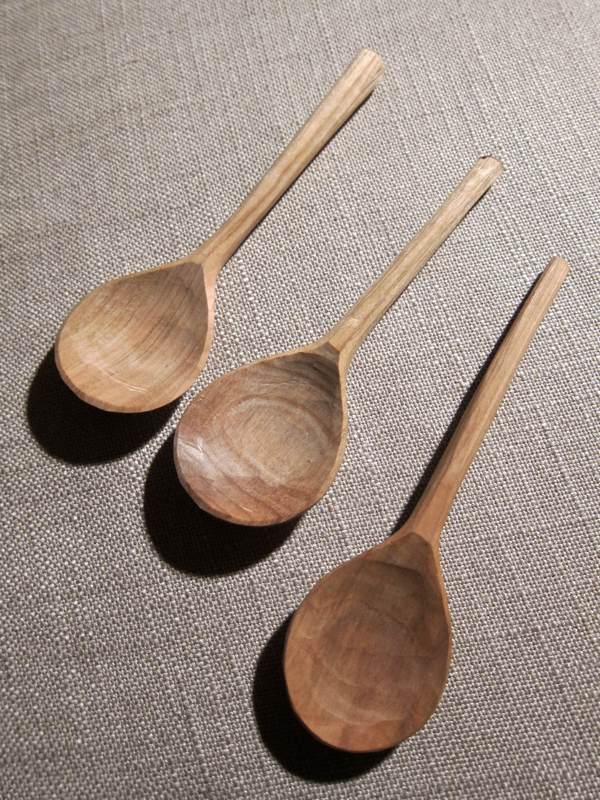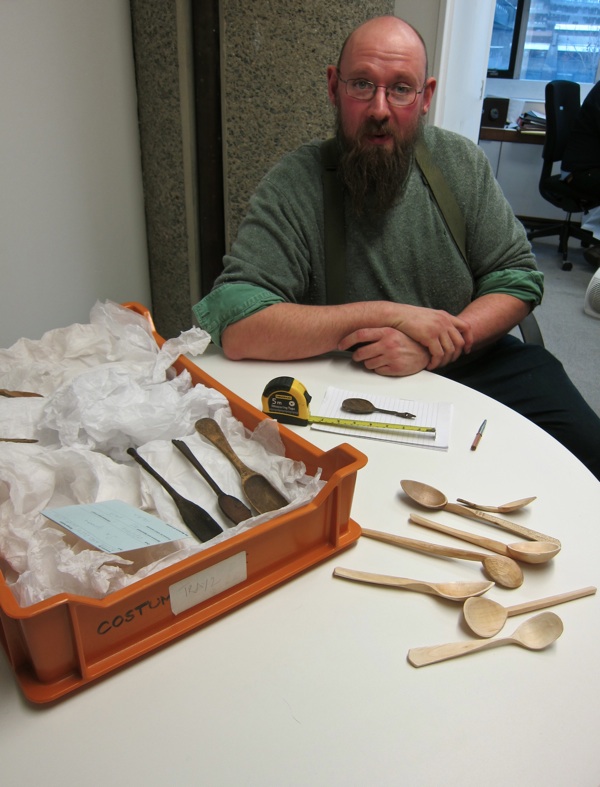Barn the Spoon examines a two-thousand-year-old spoon
When I first met Barn the Spoon, the professional spoon carver, he told me he wanted to make London spoons – but he did not know what they would be like. So I offered to help him find out and, to this end, we paid a visit upon Roy Stephenson, Head of Archaeological Collections at the Museum of London, recently to take a look at some old spoons in his collection.
Barn’s eyes sparkled with excitement from the moment they fell upon the ancient spoons lain upon tissue, though Roy was a little apologetic at the dearth of such artefacts in his collection. We learnt that there is a mystery surrounding the lack of Medieval spoons discovered in London compared with other European capitals. “We might not have got lucky yet,” Roy admitted, “or they might have been using horn spoons that have decomposed.”
Fortunately, sufficient spoons have survived to fascinate Barn the Spoon and, with Roy’s permission, he began to lift each one in turn and scrutinise it lovingly. As I watched him, I thought of what Barn had told me once – that he could look at any wooden spoon and know how it was made. In his mind, Barn was travelling across time and making contact with the spoon carvers of Medieval London. “If I met the maker of one of these, I could immediately have a conversation with them,” he confided to me, “I’d have more in common with them than I do with most people today.”
Barn was curious that they all so tiny and I wondered if this was because people had smaller hands centuries ago, but Roy was able to resolve this dilemma for us by explaining that the wood had shrunk over the centuries. Two spoons in particular caught Barn’s attention, a modest fig-shaped apple wood Medieval spoon collected from Railway Approach, London Bridge in July 1914, and an alder wood spoon of more formal design with a pattern of incised bands across the shaft. Roy showed us another similar alder wood spoon found in Tabard St in the City of London 1912, housed in a display devoted to the Rose Theatre and artefacts of Shakespeare’s era,.
“The experience of holding them,” Barn revealed to me as we walked back east through the City, “it was soothing, like coming home, because in my mind I live in a world where spoons are made with axes and knives, so those designs were familiar to me – and they came from here.”
Three days later, Barn surprised me when I dropped in to visit him, by tumbling a fistful of spoons in these same designs into my hand with a burst of triumphant laughter. I was filled with awe to see new spoons in these age-old styles that would have been familiar to our distant forebears. All were subtly different, just as every one of Barn’s spoons is unique, but the spirit of the originals was still present. “It’s about trying to wean yourself away from your natural tendencies and towards the tendencies of the people who first made them and get inside their spoon carving mentality,” Barn confessed, turning contemplative as he saw me wondering over the spoons, “I’ve made about twenty to get a good idea of how they were made, specifically the cuts used and their sequence.” In fact, he had manufactured two of the “Shakespearean” spoons but more than twenty-five of the Medieval one – this most humble of artefacts was the spoon that had caught his imagination.
“Making spoons professionally, I’ve always shied away from that design in the past – which is linked to how quick and easy they are to make, but I realised there’s a very beautiful naive aesthetic.” he told me, “it’s like doing a different dance and I like it.” In contrast to the later design, which more closely resembled spoons we used today, these spoons in the Medieval design spoke of those Londoners in an earlier world who long ago huddled by fires to enjoy their bowls of porridge, broth or stew, eaten with the most utilitarian of implements. “It was fascinating to hold those old spoons at the museum and, by trying to copy them, I learnt something new,” Barn assured me fondly, “I loved making those spoons in this design, when I had once turned my back on it.”
“That particular one, I shall be offering it for sale in my shop permanently,” he informed me, continuing his thought, “and I’d love to sit in the Museum of London one day, knocking them out and selling them.” It was a satisfying notion, yet we realised that our quest was not over – we shall be taking these new spoons back to the museum to see how they closely they compare with their venerable antecedents, the spoons of old London.
A fig-shaped apple wood Medieval spoon collected from Railway Approach, London Bridge in July 1914
An alder wood spoon with incised band decoration, of a design used in Shakespeare’s London.
“If I met the maker of one of these, I could immediately have a conversation with them.”
Barn the Spoon’s versions of the Medieval London spoon in cherry.
Barn the Spoon’s versions of the Shakespearian spoon in hawthorn.
“The experience of holding them – it was soothing, like coming home, because in my mind I live in a world where spoons are made with axes and knives, so those designs were familiar to me – and they came from here.”
London Spoons are available from Barn the Spoon at 260 Hackney Rd, E2 7SJ. Friday – Tuesday, 10am – 5pm.
You may also like to read my original pen portrait
and






